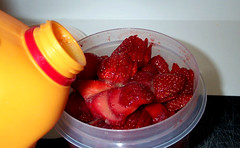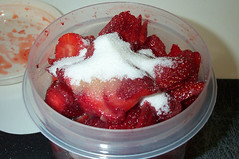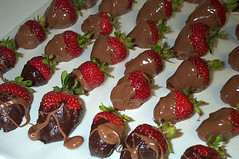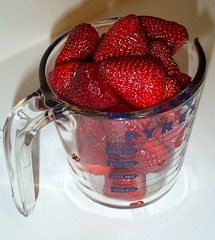To begin with, the Christmas Eve meal is vegetarian. However, this came from a time when "vegetarian" meant "not animal", so part of the meal is fish. I waffled between liking this and not liking this part. Other parts of the meal usually flipped around in favor as well, depending on my tastes at the time.
The meal begins at the time the first star is sighted. This may be difficult if the sky is overcast or you live in a city. Substitution of a blinking plane is acceptible. The meal itself is the Wigila, the Vigil. One should put a white tablecloth on the table and leave an extra place setting for absent family members. Please note that small children in the family will probably object to this custom, as it interferes with their sense of what is right. Ignore them.
The meal opens with soup, a potato-mushroom one. Growing up, this was Campbell's— one can each of cream of potato and cream of mushroom. But since I've grown up and learned to cook, it's much more fun to make from scratch. This dish can be made early and heated up at the last minute.
Thick and Chunky Potato-Leek-Mushroom SoupThe next course of the meal is the main course. This includes a fried white fish, boiled cabbage or sauerkraut (oddly enough, I never quite liked this part), and pierogi (little Polish dumplings) filled with things such as prunes and cottage cheese with cinnamon.
You will need:
-Leeks. My original recipe calls for three medium leeks but they grow them really big around here, so I use one large. This is oniony, so increase or decrease it based on your preferences.
-Potatoes. Again, this calls for four "medium" potatoes and I have yet to run across a truly medium potato.
-Butter. Ain't nothing like the real thing, and you'll need a lot for another dish.
-Mushrooms. The standard store mushroom is fine, but Crimini (Italian Brown) mushrooms are similar in taste to Portabella mushrooms, but cheaper.
-Chicken broth. Buy the low-sodium kind or make your own. Yes, you can use vegetable broth as well.
-Milk.
-Salt and white pepper, unless you don't care about little black flecks in your food, in which case black pepper works fine.
Cut off the green stems of the leeks and wash to remove sand. Cut them longwise and then crosswise into little chunks. Melt the butter over low heat in your soup pot and saute the leeks until soft, about five minutes.
Peel and cut the potatoes into inch-wide chunks. Throw them into the pot. Cut up the mushrooms. Throw them into the pot. Use enough broth to cover the potatoes and mushrooms and set the heat to simmer. Partially cover the pot and simmer until the poatoes are cooked, about 45 minutes. At this point you can set it aside to wait for later.
It's later, so get out your blender. I generally pull out half of the chunks or potato and put them in the serving bowls, then take the remainder and put it in the blender with milk and spices to taste. (Remember, liquids first! Don't burn out your blender; fried electronics have an unappetizing smell.) Blend until smooth— you may have to do this in sections— and reheat if necessary, then pour over the chunks of potato. Serve immediately.
No, really. It's actually supposed to be a soft cheese with cinnamon. Cottage cheese not only fits the bill, it's quite common in this regard.
Last year, for the pierogi, my sister served Trader Joe's Potato Cheese Pierogi. My father— the one who was raised with this traditional meal— tasted them, and said they tasted nothing like what he grew up with. After a pause, he added, "This is much better." This company sells pierogi, if you don't have a Trader Joe's in your area— that would be anyone who doesn't live in the Western states.
If you want to cook your own, Cooks.com has a bunch of recipes. Just remember that fillings such as prunes, raisins, and cottage cheese are among the traditional ones. No wonder my interest waffled.
As for the fish, pick one that is native to your area for the best effect, though I'd avoid catfish. It is to be fried in butter with slices of hard-boiled egg. You may see some recipes refer to "brown butter"— this is a high-fat European variety that is often available in the supermarket under varying names. This Thanksgiving I was treated to pumpkin ravioli fried in brown butter and sage, and I can attest that it is Oh. So. Good. Be careful not to burn the butter, though.
And then we come to the cabbage. I never liked this part, but I've found some recipes that may improve on the simple "boil and add salt and pepper" method.
Cabbage With CarawayCaraway is apparently one of the traditional Polish spices.
You will need:
-Water
-Onion, fresh or dried
-Caraway seeds
-Salt
-Small head of cabbage
-A big pot
Boil about a quart of water with a little minced onion, salt, and caraway seeds. After about ten minutes, cut the cabbage into small wedges and boil until tender, but not so long that the whole thing is mush. Serve immediately.
Boiled Red CabbageNow we move on to the fruitbread. This is some sweet bread with dried fruits in it.
You will need:
-1 small red cabbage, quartered and thinly sliced
-1 tart apple, grated
-butter (again!)
-1/4 cup vinegar (I suggest apple cider vinegar, for consistency)
-1/2 cup red currant jelly
-1/4 cup water
-salt
I don't know the specific name for this kind of pan, but one of those saucepans that looks like a cross between a handled pot and a frying pan, with a lid, is a pretty good bet for this recipe. Melt the butter over gentle heat, then add everything else, cover, and simmer for about one hour, stirring occasionally. The vinegar will help the cabbage retain its color.
And let the fruitcake jokes begin. I never understood these jokes as a child— I loved fruitcake. When I got older, I discovered that not all fruitcakes are created equal. Those nasty, brutish things you get from some supermarkets, or that horrible concoction with the unverifiable fruitlike things that your Aunt Martha made are the source of all the jokes. Instead, we got our fruitcakes sent to us from some company in Texas that made a moist, molasses-wonderful confection.
I'd link, but I have no idea who they are. Instead, I'll link the Harry & David site, as their fruitcake is similarly tasty. (You know Harry & David. They're the Fruit of the Month Club™ guys.) Or if you make your own, carefully marinating it over several months with high-quality rum, please don't burn it as my friend Stephanie's aunt invariably did. As she said, "We assumed it was good, but it never got as far as the table."
Okay. The final part to the meal is the sharing of the oplatek, a thin unleavened wafer (available through the internet.) The oldest person breaks it with the next oldest, then that person with the next, and so on down the line until everybody has broken oplatek with everyone else and there are little unleavened flakes all over the floor. Then you eat it and it gums up your teeth.
Ah, memories. Shortly afterwards we were sent to bed so we could get up in time for Midnight Mass, and my parents would assemble any presents that needed assembly. One year, I could make absolutely no sense out of the sounds coming from the front room— a sort of whirring, grinding sound.
That was the year I got an electric train, HO scale. Very cool, and it's still somewhere at my parents' place...







































